Intel Core i7 4960X (Ivy Bridge E) Review
by Anand Lal Shimpi on September 3, 2013 4:10 AM EST- Posted in
- CPUs
- Intel
- Ivy Bridge
- Ivy Bridge-E
Video Transcoding
With our lightly threaded tests behind us, it's time to move to more CPU intensive pastures.
We migrated to the latest verison of the x264 HD benchmark which features a much newer version of x264 and a much heavier workload. The focus here is on quality rather than speed, thus the benchmark uses a 2-pass encode and reports the average frame rate in each pass.
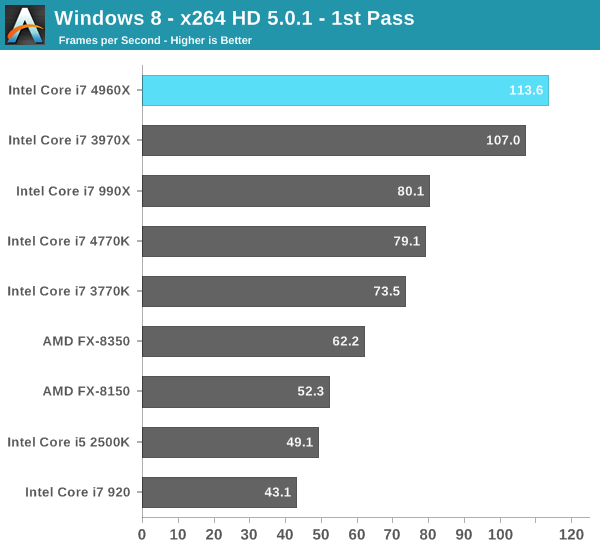

Here we see all of the 6-core parts rise to the top, including Intel's old Gulftown based Core i7-990X. Despite being a few years old at this point, the 990X's 6-core design and relatively high clock speed gives it better performance here than the quad-core Haswell 4770K.
The 4960X manages to be around 30% faster than the old 990X, and is 40% faster than the 4770K. For heavily threaded applications, there's simply no replacement for more cores.
Just like I did earlier, I dusted off one of our really old x264 tests so we'd have comparison data to even older CPUs including the Pentium 4 and Penryn based Extreme Edition parts:
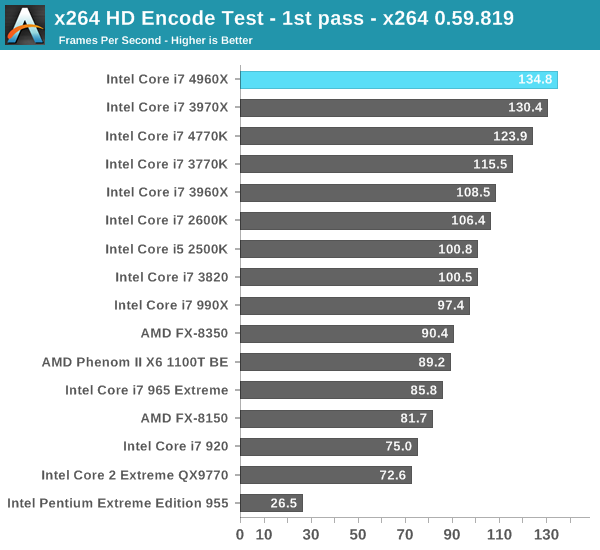
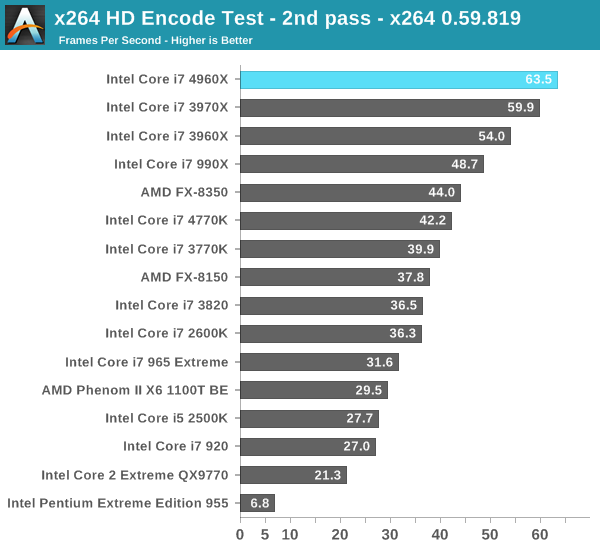
The 4960X manages to deliver nearly 3x the performance of Intel's flagship from 6 years ago. The Pentium EE 955 comparison is even more insane. IVB-E is basically an order of magnitude faster than the last high-end Pentium 4s to come out of Intel back in 2005.
3D Rendering
Our new POV-Ray benchmark uses the latest beta binary (3.7RC6) and runs through both single and multithreaded versions of the popular raytracing benchmark.
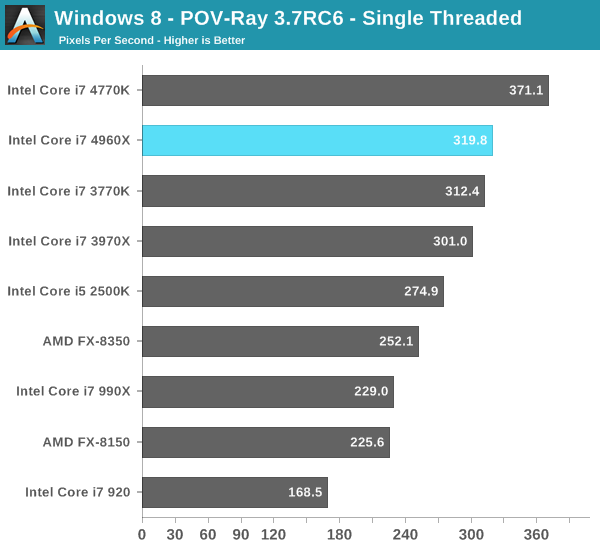
Isolating a single core shows us exactly what we're missing by having Ivy Bridge at the heart of the 4960X instead of Haswell. Here the 4770K manages a 16% performance advantage over the 4960X, which costs 3x as much and draws substantially more power. Looking at AMD's FX-8350 however it's clear why Intel can get away with launching a high-end 6-core chip without its latest cores. Piledriver's single threaded performance falls somewhere between Nehalem and Sandy Bridge, giving Intel room to launch another Ivy Bridge based high-end SKU in 2013 and get away with it.
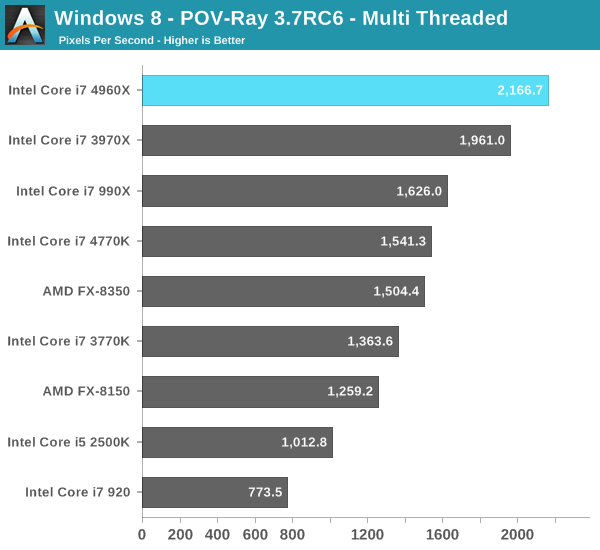
The multithreaded performance story is very different. Here even the Gulftown based 990X is faster than Haswell thanks to its six cores. The 4960X is 40% faster than the Haswell based 4770K. Even AMD's FX-8350 does really well here, basically equalling Haswell's performance.
Created by the Cinema 4D folks we have Cinebench, a popular 3D rendering benchmark that gives us both single and multi-threaded 3D rendering results.
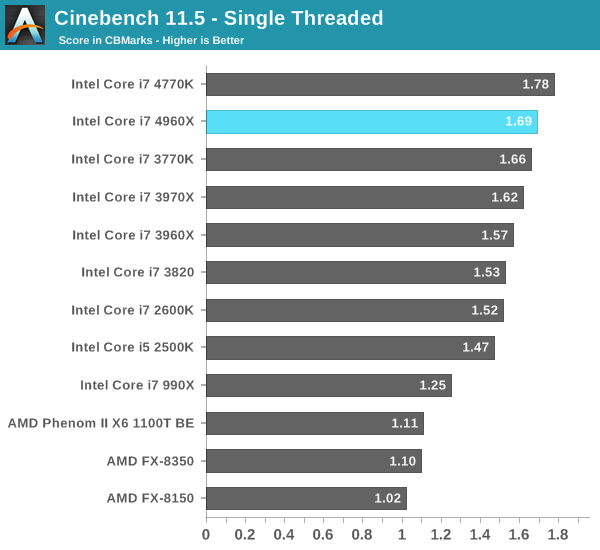
In Cinebench, the single threaded Haswell/IVB-E gap narrows to 5%.
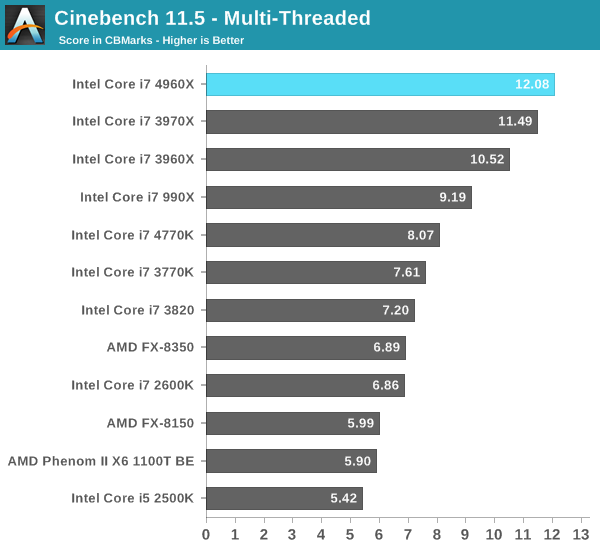
Multithreaded performance continues to be just stellar. Here the 4960X is just under 50% faster than the 4770K. Note the relatively small gap between the 4960X and the SNB-E based 3970X however - the performance gain is only 5%. The bulk of Ivy Bridge's advancements were in GPU performance (not applicable to IVB-E) and power consumption (which we'll get to shortly).
Our final two Cinebench tests use the R10 benchmark to enable a comparison to more/older data points:
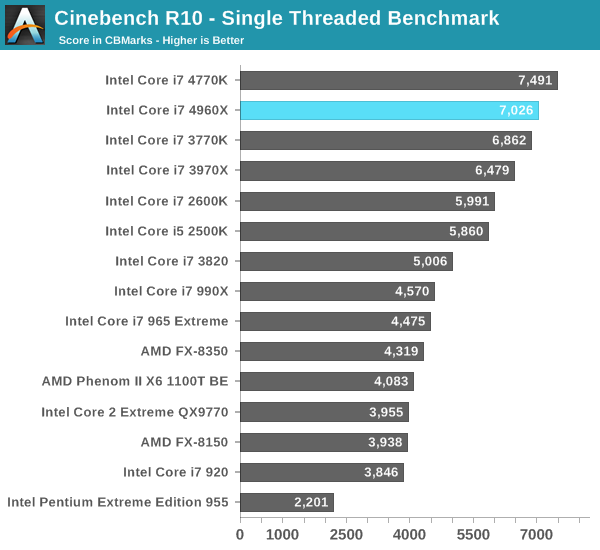
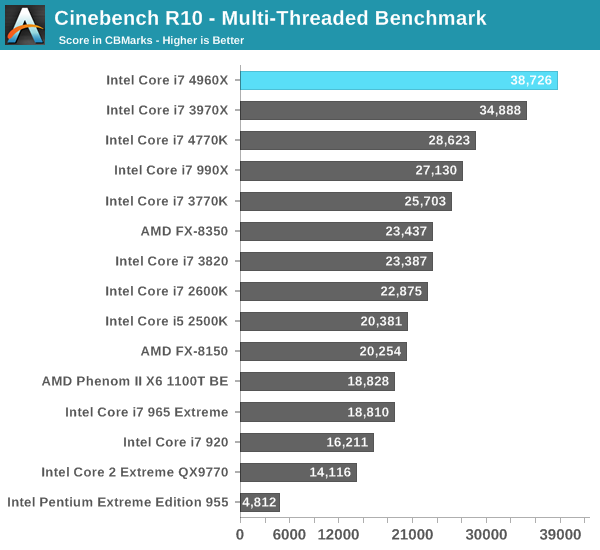










120 Comments
View All Comments
randfee - Tuesday, September 3, 2013 - link
anyways, I am likely to wait for Haswell XEONs next year, with AVX2 (which greatly enhances such scientific calculations if used) and DDR4 ;)noeldillabough - Thursday, September 5, 2013 - link
dual Xeons, I have a supermicro 2U unit with low voltage xeons (they were $650ish each) and they're great. You can pick and choose board to have as much ECC memory as you want!wallysb01 - Tuesday, September 3, 2013 - link
The E5-1660 will be the same as the 4960X, just not unlocked and with ECC. Same 6 cores, same 3.6-4.0 GHz range. Is the overclocking really worth all the hassle for maybe 20% speed increase, even if you had ECC?But I generally agree, it looks like Ivy Bridge 49xx/E5-16xx v2 is probably worth skipping. The upgrade over Sandy is not that much, and Haswell will likely bring 8-cores to the 59xx/16xx v3 space. Ivy Bridge for the top end only really made big gains in the 26xx space thanks to adding 10 and 12 core options, but man do you pay for them....
mapesdhs - Wednesday, September 4, 2013 - link
You sound like the kind of person who'd benefit from a used SGI UV 10 or UV 100.
No idea about their availability though.
Ian.
mapesdhs - Wednesday, September 4, 2013 - link
Oops, I was replying to randfee btw. Apologies for any confusion.Ian.
FwFred - Wednesday, September 4, 2013 - link
Intel offers plenty of parts for you. See the Xeon line--it doesn't need to be high end.JlHADJOE - Tuesday, September 3, 2013 - link
Intel Marketing: Honest guys.Michael REMY - Wednesday, September 4, 2013 - link
VERY VERY congratulation to Anandtech for having put in the test the old flagships cpu ! Now we can really compare and read more & more deeper the evolution and interest in this architecture.It is great that someone underdstood people do not buy or change each year their whole computer, but only every 3-4 year .
Very Thank you my Lord Anandtech
Remarius - Wednesday, September 4, 2013 - link
Would be fascinated to see some statistics re tri and quad sli usage as I'm already using 3 titans. There seems to be almost no coverage at that end of the scale despite being one of the target markets for this chip.noeldillabough - Thursday, September 5, 2013 - link
Heh I'd be happy with ONE Titan :) But I'd love to see those results too!